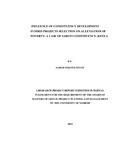| dc.description.abstract | Poverty alleviation is worldwide concern and
both
the developed and
undeveloped nations use different ways to reduce poverty (UNDP, 2013).
Hence,
in Kenya,
the CDF
is used to thi
s end and its
aim
is to
redistribute
national
resources to the
constituencies
.
T
his study
focused
on the influence of
Constituency Development Funded projects selection on alleviation of poverty, a
case of Saboti constituency, Kenya. The
study had four
obj
ectives
and it
targeted
CDF officials and
households
.
It
purposively sampled the CDF officials
and
employed Yamane (1967)
formula
to determine the sample size for the
households
(100)
.
The
data was gathered using
questionnaires, interviews and
observation
schedules.
The collected data w
as
analyzed using SPSS and content
analysis.
T
he key findings for objective 1 comprised:
the basis for CDF project
selection
as put forth by CDF officials
was
c
ommunity empowerment and
utility
;
household respondents
attesting
to the fact that the community
participated
in project selection and
in all the
Wards
, over 50% of the
respondents
alluded to
community participated in project implementation
. For
objective 2:
over
60%
of the respondent in each Ward
regarded selected
proj
ect
s
a priorty for the community;
t
he CDF officials ranked the projects selected in
terms of service delivery
with
45%
being
good, 30% aver
age, 15% very good
and 10% poor;
households
ranked
the projects in order of priority
and
it’s only
the roads that had
a 61% for the first rank
; households response on
the status of
CDF projects reveal
ed
that Tuwan had
the highest (
75.9%
) while
Saboti
the
lowest (
44.4%
) of
complete
d
an
d in use projects;
55.3%
of the households
noted that
selection of Project Management C
ommittee was done by community
and the member of parliament. For objective 3:
over 60% of
households
respondents
were
either very satisfied or satisfied
with the selected
schools,
water, health
, farming and business
projects
;
there were 40% for school, 76.
5%
for water, 71.4%, 52% for farming and 83.3% for business in favor of p
rojects’
transparency
;
72.4% for Tuwan, 70% for Machewa and Kinyoro, 69.6 for Matisi
and 33.3%
for Saboti
perceived the
projects to have high im
pact on community
because the benefits
spread to many people
;
the officials perceived that
more
funds, proper managerial struc
tures and technical support were the highly
needed resource needs for project selection. For objective 4:
the CDF officials
revealed
that corruption and
poor community l
eadership were the greatest
challenges in project selection; over 85% of the respondents
across
different
aspects
agreed that they
experienced
negative impact of poverty
to the
community
.
The study concludes that project selection is a delicate and pivotal
point of community initiatives towards poverty alleviation. It also recommends
that
that CDFC be capacity build more often and where possible exchange
programmes between constituencies be promoted so that best practices can be
transferred and be replicated | |

